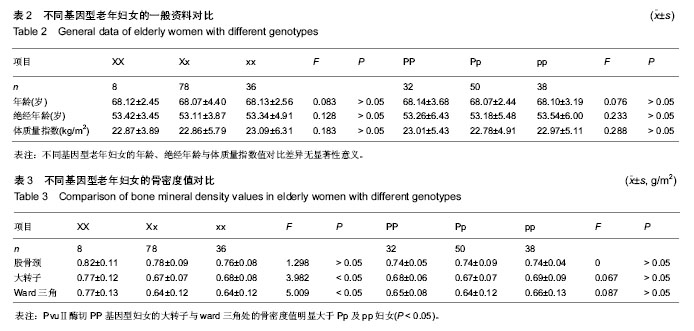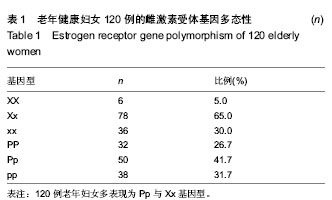| [1] Stanton H, Rogerson FM, East CJ, et al. ADAMTS5 is the major aggrecanase in mouse cartilage in vivo and in vitro. Nature.2005;434(3):648-652.
[2] 李静怡,栾杰.雌激素受体α基因PvuⅡ和XbaⅠ多态性与乳房肥大的关系[J].中华实验外科杂志,2014,31(2):413-415.
[3] Wong KC, Lee KS, Luk HK, et al. Er-xian Decoction exerts estrogen-like osteo-protective effects in vivo and in vitro. Am J Chin Med.2014;42(2):409-426.
[4] 秦燕,田玉峰,孙树凯,等.绝经后糖脂代谢异常妇女雌激素受体α基因多态性观察[J].中华全科医师杂志,2014,13(2): 147-148.
[5] Sonya S. G1asson, Roger Askew, Barbara Sheppard, et al. Deletion of active ADAWrS5 prevents cartilage dergradation in a murine modle of osteoarthritis. Nature.2005;434(3): 644-647.
[6] 辛佳蔚,章军建,杨英,等.雌激素受体β基因多态性与老年女性高血压的相关性[J].中华医学杂志,2013,93(21):1657-1659.
[7] Sacco SM, Chen J, Ganss B, et al. Flaxseed enhances the beneficial effect of low-dose estrogen therapy at reducing bone turnover and preserving bone microarchitecture in ovariectomized rats.Appl Physiol Nutr Metab. 2014;39(7): 801-810.
[8] 刘德宝,张复文,任振华.雌激素受体α介导小鼠骨髓间充质干细胞成骨分化[J].中国骨质疏松杂志,2014,3(12):228-233.
[9] Kim MH, Choi YY, Han JM, et al. Ameliorative effects of Schizandra chinensis on osteoporosis via activation of estrogen receptor (ER)-α/-β. Food Funct. 2014;5(7): 1594-1601.
[10] 郑一君,李治琴,戴青,等.初发系统性红斑狼疮患者雌激素受体表达及与骨量异常的关系[J].中国骨质疏松杂志,2014,3(11): 225-227.
[11] 卞子辰.雌激素及其受体与骨性关节炎相关性研究进展[J].医学综述,2014,20(7):1172-1174.
[12] Wang Y, Yang C, Xie WL, et al. Puerarin concurrently stimulates osteoprotegerin and inhibits receptor activator of NF-κB ligand (RANKL) and interleukin-6 production in human osteoblastic MG-63 cells. Phytomedicine. 2014;21(8-9): 1032-1036.
[13] 胡飞雪,王庭槐,谈智.小窝蛋白-1在膜雌激素受体介导的内皮祖细胞增殖中的作用[J].中华心血管病杂志,2011,39(11):99-101.
[14] Roforth MM, Atkinson EJ, Levin ER, et al. Dissection of estrogen receptor alpha signaling pathways in osteoblasts using RNA-sequencing.PLoS One.2014;9(4):e95987.
[15] 王婉,赵兴利,刘晶,等.雌激素受体拮抗剂对垂体腺瘤GH3细胞增殖、凋亡、催乳素分泌及雌激素受体蛋白表达的影响[J].中华神经外科杂志,2012,28(3):123-124.
[16] Wistedt A, Ridderstråle Y, Wall H, et al. Exogenous estradiol improves shell strength in laying hens at the end of the laying period.Acta Vet Scand.2014;56(1):34-35.
[17] 王凤翔,董桂芳,王素杰,等.雌激素与绝经后膝骨性关节炎相关分析[J].慢性病学杂志,2010,12(8):78-79.
[18] 刘芳,其木格.稽留流产患者血液和绒毛中雌激素受体a基因多态性的表达[J].中华医学杂志,2012,92(9):78-81.
[19] 柯江维,杨玉,段荣,等.雌激素受体基因多态性与女孩性早熟关系的研究[J].江西医学院学报,2009,49(7):122-124.
[20] 龙丽,单可人,赵艳,等.荔波瑶族、汉族雌激素受体α基因多态性与乙型肝炎病毒感染关系的研究[J].临床荟萃,2009,24(15): 99-101.
[21] 钱春野,杨留才,李向荣,等.雌激素受体2基因多态性与青年胃腺癌的关联分析[J].苏州大学学报:医学版,2009,29(5):38-40.
[22] 袁瑞,乐爱文,耿力,等.雌激素受体α基因多态性与原因不明月经过少的相关性研究[J].中国医科大学学报,2007,36(4): 77-78.
[23] 潘凌云,袁巧玲,李苑.雌激素受体α基因多态性与子宫内膜增生症的相关性研究[J].南昌大学学报:医学版,2011,51(1): 110-111.
[24] 龙丽,单可人,任锡麟.雌激素受体(ESR)基因多态性与疾病相关性的研究进展[J].国际遗传学杂志,2008,31(2):56-58.
[25] 乐爱文,袁瑞,姚珍薇,等.原因不明月经过少雌激素受体α基因多态性及其表达的研究[J].生殖与避孕,2007,27(10):119-121.
[26] 刘源,李燕,孙月池,等.雌激素受体α基因XbaⅠ位点多态性与骨关节炎易感性相关性的Meta分析[J].中华临床医师杂志:电子版,2013,3(3):89-91.
[27] Eriksen MB, Glintborg D, Nielsen MF, et al. Testosterone treatment increases androgen receptor and aromatase gene expression in myotubes from patients with PCOS and controls, but does not induce insulin resistance.Biochem Biophys Res Commun. 2014;451(4):622-626.
[28] Elraiyah T, Sonbol MB, Wang Z, et al. The Benefits and Harms of Systemic Testosterone Therapy in Postmenopausal Women With Normal Adrenal Function: A Systematic Review and Meta-analysis.J Clin Endocrinol Metab. 2014;99(10): 3543-3550.
[29] Mohammadi Z, Fayyazbakhsh F, Ebrahimi M, et al. Association between vitamin D receptor gene polymorphisms (Fok1 and Bsm1) and osteoporosis: a systematic review.J Diabetes Metab Disord. 2014;13(1):98.
[30] de la Croix Ndong J, Makowski AJ, et al. Asfotase-α improves bone growth, mineralization and strength in mouse models of neurofibromatosis type-1.Nat Med. 2014;20(8):904-910.
[31] Fuchigami T, Kibe T, Koyama H, et al. Regulation of IL-6 and IL-8 production by reciprocal cell-to-cell interactions between tumor cells and stromal fibroblasts through IL-1α in ameloblastoma.Biochem Biophys Res Commun. 2014;451(4): 491-496.
[32] Antonopoulos AS, Margaritis M, Coutinho P, et al. Reciprocal effects of systemic inflammation and brain natriuretic peptide on adiponectin biosynthesis in adipose tissue of patients with ischemic heart disease.Arterioscler Thromb Vasc Biol. 2014; 34(9):2151-2159.
[33] Holden JA, Attard TJ, Laughton KM, et al. Porphyromonas gingivalis lipopolysaccharide weakly activates M1 and M2 polarized mouse macrophages but induces inflammatory cytokines.Infect Immun. 2014;82(10):4190-4203. |

